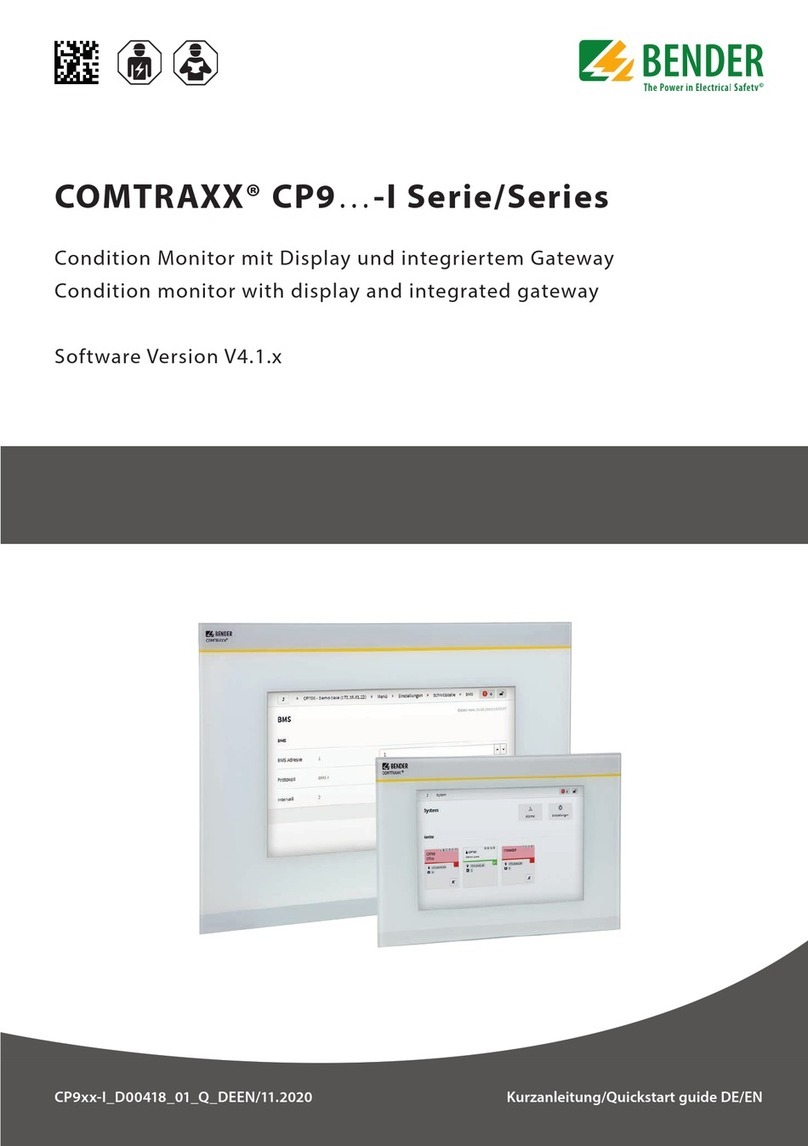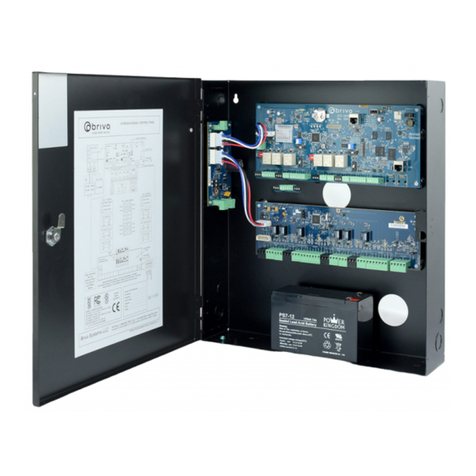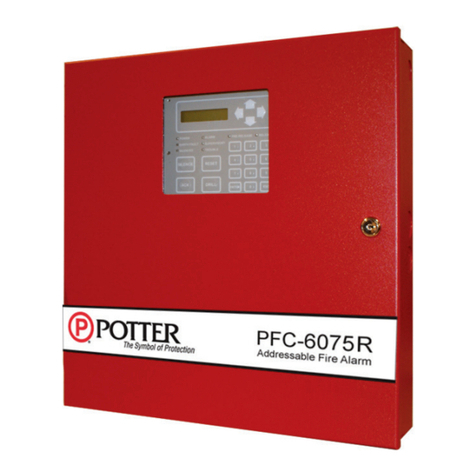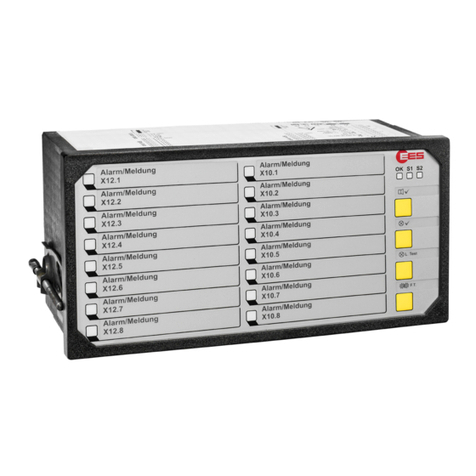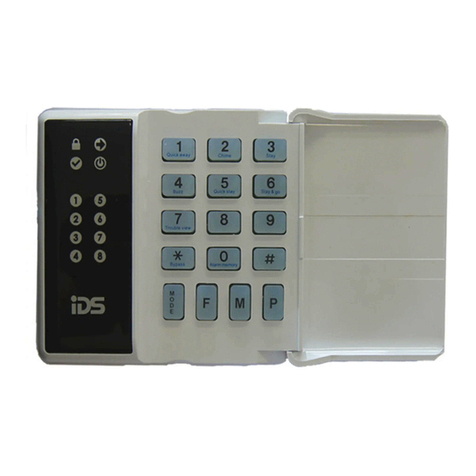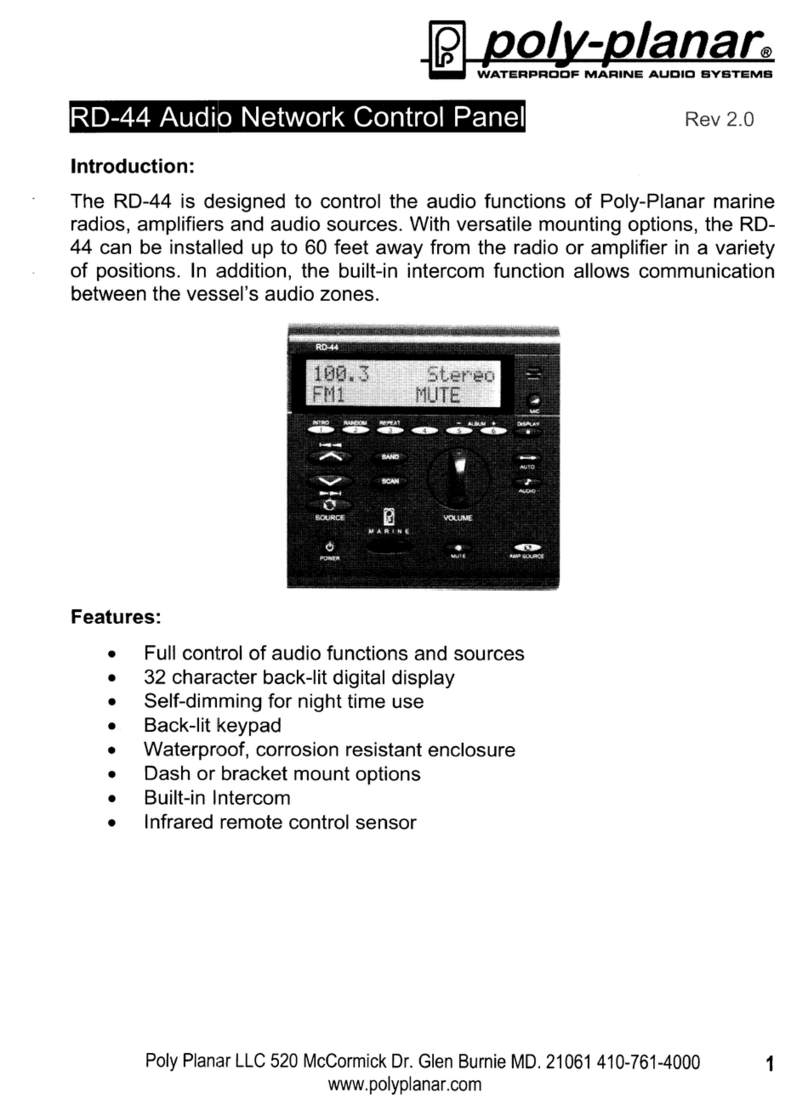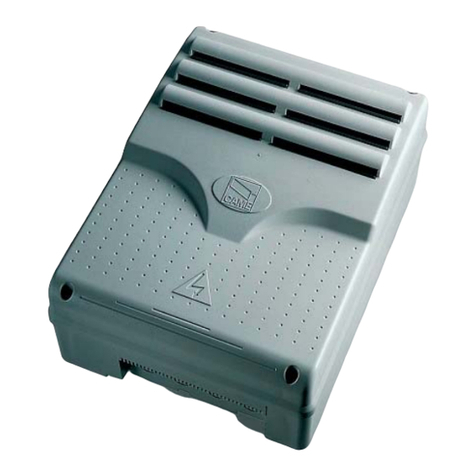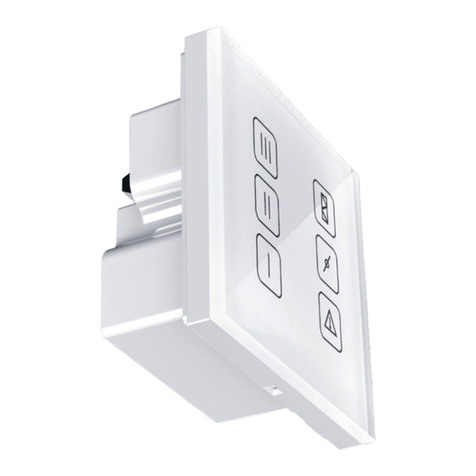Networker TS690R Assembly instructions

TS690R
Wireless Intruder Alarm
Control Panel
Installation & Programming
Manual
123
456
789
ENT 0ESC
ABC
OMIT
BELL TEST
NEW CODE
ZONE OMIT
WALK TEST
CHIME
SILENT
FULL SET
RESET
24Hr OMIT
AREA
TS690R SYS OPEN
123
456
789
ENT 0ESC
ABC
OMIT AREA
POWER SYS OPEN
123
456
789
ENT 0ESC
ABC
OMIT AREA
POWER FUNCTION

Contents
Overview
Introduction . . . . . . . . . . . . . . . . . . . . . . . . . 4
Control Panel . . . . . . . . . . . . . . . . . . . . . . . . 4
Jamming Detection . . . . . . . . . . . . . . . . . . . 4
Wireless Detectors. . . . . . . . . . . . . . . . . . . . . 4
502r Watch Pendant PA . . . . . . . . . . . . . . 4
509r Fire Detector . . . . . . . . . . . . . . . . . . . 4
520r Passive Infra Red. . . . . . . . . . . . . . . . 4
525r Remote Setting Device. . . . . . . . . . . 4
536r Universal Transmitter . . . . . . . . . . . . . 4
Remote Keypads . . . . . . . . . . . . . . . . . . . . . 4
8 Character Starburst (TS690.STAR) . . . . . . 5
Remote Arming Station (TS700.ARM). . . . . 5
System Architecture . . . . . . . . . . . . . . . . . . . 5
TS700 LEC. . . . . . . . . . . . . . . . . . . . . . . . . . . 5
Specifications. . . . . . . . . . . . . . . . . . . . . . . . 6
Control Panel . . . . . . . . . . . . . . . . . . . . . . 6
Starburst Remote Keypad. . . . . . . . . . . . . 6
Arming Station . . . . . . . . . . . . . . . . . . . . . 6
TS700 LEC . . . . . . . . . . . . . . . . . . . . . . . . . 6
502r PIR. . . . . . . . . . . . . . . . . . . . . . . . . . . 6
509r PIR. . . . . . . . . . . . . . . . . . . . . . . . . . . 6
520r PIR. . . . . . . . . . . . . . . . . . . . . . . . . . . 6
525r Remote Setting Device. . . . . . . . . . . 6
536r Universal Transmitter . . . . . . . . . . . . . 6
System Installation
Radio Site Survey . . . . . . . . . . . . . . . . . . . . . 7
Procedure for simple Installation. . . . . . . . 7
Procedure for Certified Installation . . . . . . 7
Control Panel Location. . . . . . . . . . . . . . . . . 7
Cable Routing . . . . . . . . . . . . . . . . . . . . . . . 7
Control Panel Assembly . . . . . . . . . . . . . . . . 8
Control Panel Installation . . . . . . . . . . . . . . . 9
Mains Connection . . . . . . . . . . . . . . . . . . . . 9
Battery Connection . . . . . . . . . . . . . . . . . . . 9
PCB Layout . . . . . . . . . . . . . . . . . . . . . . . . . . 10
Remote/LEC Network Wiring . . . . . . . . . . . . . 12
Remote Keypads . . . . . . . . . . . . . . . . . . . . . 12
TS790 Star Remote Keypad . . . . . . . . . . . 12
TS700 Remote Arming Station. . . . . . . . . . 12
Installation Procedure. . . . . . . . . . . . . . . . 12
TS700 LEC Installation . . . . . . . . . . . . . . . . . . 13
Hard Wired Detection Circuits . . . . . . . . . . . 14
Double Pole . . . . . . . . . . . . . . . . . . . . . . . 14
End Of Line . . . . . . . . . . . . . . . . . . . . . . . . 14
External Sounder Connections . . . . . . . . . . . 14
Auxiliary Tamper . . . . . . . . . . . . . . . . . . . . . . 15
Extension Loudspeakers . . . . . . . . . . . . . . . . 15
Installing a 520r PIR . . . . . . . . . . . . . . . . . . . 15
Siting the 520r PIR . . . . . . . . . . . . . . . . . . . 15
Installation. . . . . . . . . . . . . . . . . . . . . . . . . 16
Testing . . . . . . . . . . . . . . . . . . . . . . . . . . . 16
Walk Testing and Lockout . . . . . . . . . . . . . 16
525r Remote Setting Device. . . . . . . . . . . . . 17
Learning . . . . . . . . . . . . . . . . . . . . . . . . . . 17
Changing the Battery . . . . . . . . . . . . . . . . 17
Installing a 536r Universal Transmitter. . . . . . 17
Siting the 536r Universal Transmitter. . . . . . 17
Using the internal Reed Switch . . . . . . . . . 18
Installation. . . . . . . . . . . . . . . . . . . . . . . . . 18
Connecting External Door Contacts . . . . . 18
Testing . . . . . . . . . . . . . . . . . . . . . . . . . . . 18
Connecting a Printer . . . . . . . . . . . . . . . . . . 19
Using the CPA6 Printer. . . . . . . . . . . . . . . . 19
Using the DATAC / RS232 Printer . . . . . . . . 19
Programmable Outputs . . . . . . . . . . . . . . . . 19
Control Panel Outputs. . . . . . . . . . . . . . . . 19
Remote Keypads & TS700.LECs . . . . . . . . 19
Pre Power-Up Checks . . . . . . . . . . . . . . . . . . 20
Initial Power-Up . . . . . . . . . . . . . . . . . . . . . . . 20
Power-Up Checks . . . . . . . . . . . . . . . . . . . . . 20
NVM Defaults . . . . . . . . . . . . . . . . . . . . . . . . 21
Engineer’s Menu 1
Introduction . . . . . . . . . . . . . . . . . . . . . . . . . 23
Menu contents . . . . . . . . . . . . . . . . . . . . . 23
Panel Outputs [1.1]. . . . . . . . . . . . . . . . . . . . 24
Programmable Output Types . . . . . . . . . . . . 24
Program Circuits [1.4] . . . . . . . . . . . . . . . . . . 26
Circuit Types . . . . . . . . . . . . . . . . . . . . . . . 26
Circuit Attributes . . . . . . . . . . . . . . . . . . . . 27
System Timers [1.5] . . . . . . . . . . . . . . . . . . . . 28
Setting Modes [1.6]. . . . . . . . . . . . . . . . . . . . 30
Remote Reset Algorithm [1.8]. . . . . . . . . . . . 30
Configuration [1.9] . . . . . . . . . . . . . . . . . . . . 31
2
TS690R Installation Manual

Goto User Menu 1 [1.0] . . . . . . . . . . . . . . . . 32
Add/Cancel Devices [1.A] . . . . . . . . . . . . . . 33
Adding Devices . . . . . . . . . . . . . . . . . . . . 33
Removing Detectors. . . . . . . . . . . . . . . . . 33
Re-Map Keypad Circuits . . . . . . . . . . . . . . . 34
Engineer's Menu 2
Introduction . . . . . . . . . . . . . . . . . . . . . . . . . 35
Menu Contents. . . . . . . . . . . . . . . . . . . . . 35
View Circuits [2.1] . . . . . . . . . . . . . . . . . . . . . 36
Set System Time [2.2] . . . . . . . . . . . . . . . . . . 36
Set System Date [2.3] . . . . . . . . . . . . . . . . . . 36
Change Passcode [2.4] . . . . . . . . . . . . . . . . 37
Chime Circuits [2.5] . . . . . . . . . . . . . . . . . . . 37
Print System Log [2.7] . . . . . . . . . . . . . . . . . . 37
Configure Part Sets [2.8] . . . . . . . . . . . . . . . . 38
View System Log [2.9]. . . . . . . . . . . . . . . . . . 38
Log Event Codes . . . . . . . . . . . . . . . . . . . . . 39
Reset User Code 1 [2.0] . . . . . . . . . . . . . . . . 39
Circuit Text [2.B] . . . . . . . . . . . . . . . . . . . . . . 40
Appendices
Setup New Users . . . . . . . . . . . . . . . . . . . . . . 41
User Types. . . . . . . . . . . . . . . . . . . . . . . . . 41
Part-Set Application Example . . . . . . . . . . . . 42
Notes . . . . . . . . . . . . . . . . . . . . . . . . . . . . . . 44
Notes . . . . . . . . . . . . . . . . . . . . . . . . . . . . . . 45
Quick Reference Engineers Menus. . . . . . . . 46
Quick Reference User Menus . . . . . . . . . . . . 46
3
TS690R Installation Manual

Overview
Introduction
The TS690R wireless alarm control system has been
designed to suit small to medium installation sites.
The system can monitor 30 wireless zones and 8
conventional zones via remote keypads or LECs.
The TS690R is designed to meet the requirements
of BS6799 class "III" and complies with all current
NACOSS codes of practice for domestic and small
business audible ONLY intruder alarm systems. The
system can be certificated by approved installers
as a Wirefree "Class III" installation.
The radio operating frequency between the
control panel receiver and the detectors is
433.92MHz with a bandwidth of 200kHz. The radio
section is approved to MPT 1340.
Control Panel
The control panel is the controlling unit for the
system, it has a power supply and connections for
a standby battery. It has the following facilities:
lOn board keypad
l8 character Starburst LCD display
lBell and strobe outputs
l3 programmable outputs
lExtension loudspeaker output
lPrinter output
lAll system program information and the 150
event log is stored in a removable non-volatile
memory (NVM)
l10 user codes + engineer's code
l2.1Ah battery capacity
Jamming Detection
The TS690R features a radio jamming detection
option which can be enabled or disabled (see
"System Configuration" on page 31. When
enabled the control panel monitors for other radio
signals on the same frequency used by the
detectors. If the control panel detects a
continuous signal for more than 30 seconds the
control panel will raise an alarm. In the unset state
the alarm causes the internal sounders to beep
every minute and the display shows "JAMMED". In
a full or part set state a full alarm is generated.
Wireless Detectors
The TS690R uses the Scantronic 500 series range of
wireless detectors. The following devices are
available:
502r Watch Pendant PA
The 502r watch pendant is designed for use as a
panic alarm for the TS690R. The 502r comprises a
plastic waterproof case that can either be worn on
a strap round the wrist, round the neck as a
pendant or clipped to a pocket.
509r Fire Detector
The 509r fire detector sends a signal to alarm
panel when it detects the presence of smoked.
520r Passive Infra Red
The 520r Passive Infra Red (PIR) is an indoor
detector which has a 10 metre range.
525r Remote Setting Device
The 525r remote setting device can be used to
set, unset and part set the alarm system. In
addition, pressing the "ARM" and "OFF" at the
same time will cause a panic alarm.
536r Universal Transmitter
The 536r universal transmitter sends a signal to
alarm panel when the associated magnet moves
away from the case, and sends a restore signal
when the magnet is re-aligned. If required, you
can wire external normally closed devices (e.g.
20mm flush contacts) to the 536r.
Remote Keypads
Up to 4 remote keypads can be connected to the
control panel. Each remote keypad has two hard
wired detection circuits and a single switched -ve
output. There are two types of remote keypads
that can be used:
4
Overview TS690R Installation Manual

8 Character Starburst (TS690.STAR)
The TS790 star remote keypad has a backlit 8
character Starburst display (LCD) and a backlit
tactile rubber keypad.
Remote Arming Station (TS700.ARM)
The Remote Arming Station only allows setting and
unsetting of the system. The unit has two indicator
LEDs, the “Power LED” and a programmable
“Function LED” (the “Function LED” may be
programmed as “Fault” or “Area Set” etc.).
System Architecture
TS700 LEC
The Local Expansion Card (LEC) provides two
programmable hard wired detection circuits and
one programmable output.
5
TS690R Installation Manual Overview
Speaker
Printer
Aux 12V
Bell output
Strobe output
Outputs 1- 3
Remote
Network
On board Keypad
and LCD display
TS690R 2 Zones
(DP / EOL)
1Output
Remote
Keypad
or LEC
2 Zones
(DP / EOL)
1Output
Remote
Keypad
or LEC
2 Zones
(DP / EOL)
1Output
Remote
Keypad
or LEC
2 Zones
(DP / EOL)
1Output
Remote
Keypad
or LEC
Up to 30 wireless detectors
Remote
Setting
Device
525r
Universal
Transmitter
535r
Fire
Detector
509r
Watch /
Pendant
(P/A)
502r
Passive
Infra
Red
515r
Figure 1. TS690R System Architecture

Specifications
Control Panel
Part No.: TS690R
Input Supply: 230V ±10% 50Hz
Current: 120mA (normal)
300mA (alarm)
Power Supply: 750mA
Standby Battery: 2.1Ah
Zones 30 Wirefree devices
8 hard wired via
remotes/LECs
Outputs 1-3: 1 = Switched -ve @100mA
2 = Switched -ve @100mA
3 = Switched -ve @100mA
Speaker Output: 16 Ohms
Bell Trigger: Switched -ve @500mA
Strobe Trigger: Switched -ve @500mA
Dimensions: 205(W) x 205(H) x 64(D) mm
Material: 3mm white Polycarbonate
Weight: 1.4 Kg
Environment: -10 to 55°C
Starburst Remote Keypad
Part No.: TS790.STAR
Display: 8 character Liquid Crystal
Current: 50mA (normal) 60mA (alarm)
Zones: 2
Output: Switched -ve @100mA
Dimensions: 130(W) x 130(H) x 30(D) mm
Material: 3mm white Polycarbonate
Weight: 280g
Environment: -10 to 55°C
Arming Station
Part No.: TS700.ARM
Display: Power LED
Programming function LED
Current: 30mA (normal) 40mA (alarm)
Zones: 2
Output: Switched -ve @100mA
Dimensions: 130(W) x 130(H) x 30(D) mm
Material: 3mm Polycarbonate
Weight: 280g
Environment: -10 to 55°C
TS700 LEC
Part No.: TS700.LEC
Current: 30mA (normal) 40mA (alarm)
Zones: 2
Output: Switched -ve @100mA
Dimensions: 142(W) x 820(H) x 36(D) mm
Material: 3mm Polycarbonate
Weight: 213g
Environment: -10 to 55°C
502r Watch Pendant
Part No.: 502rUK-00 (Scantronic)
Power Supply: Two AAA Alkaline batteries
Range: 50 metres (typical)
Power Life: Approximately 14 months
Environment: -10 to 55°C
509r Smoke Detector
Part No.: 520rEUR-50 (Scantronic)
Power Supply: Two AAA Alkaline batteries
Range: 50 metres (typical)
Power Life: Approximately 14 months
Environment: -10 to 55°C
520r PIR
Part No.: 520rUK-00 (Scantronic)
Power Supply: Two AA Alkaline batteries
Range: 50 metres (typical)
Power Life: Approximately 14 months
Environment: -10 to 55°C
525r Remote Setting Device
Part No.: 525rEUR-00 (Scantronic)
Power Supply: Duracell DL 1/3N (Alkaline)
Range: 50 metres (typical)
Power Life: Approximately 14 months
Environment:-10 to 55°C
536r Universal Transmitter
Part No.: 536rUK-00 (Scantronic)
Power Supply: Two AAA Alkaline batteries
Range: 50 metres (typical)
Power Life: Approximately 14 months
Environment: -10 to 55°C
6
Overview TS690R Installation Manual

System Installation
Radio Site Survey
With a wirefree system we recommend that you
carry out radio tests as part of a site survey to
ensure that the control panel can receive the
radio signal from the detectors. If you cannot do
the tests during a survey, carry them out before
installation.
Procedure for simple Installation
1. Place the control panel in its planned location.
2. Power up the control panel.
3. Program the control panel to learn a detector
on zone 1, as this zone defaults to a night
circuit with the chime attribute.
4. Ensure the panel is back in the unset mode.
5. Test the reception by triggering the detector at
each planned location. If the control panel
generates a chime tone the detector is being
received.
Procedure for Certified Installation
You will need a 545r Radio Signal Strength meter
and a 546 Test Transmitter.
1. Switch the test transmitter on and place it at the
proposed site for the control panel. The
transmitter sends a pulsed signal, 10 seconds
on and 5 seconds off.
2. Switch the test meter into "Track" mode and
walk around the premises.
3. Check that the signal strength is between 5 - 9
at each proposed location for detectors.
4. Move to a different location to improve the
signal strength if it is between 1 - 4. Make sure
the new location is suitable for the detector.
5. Change the location of the test transmitter if
the signal strength is not greater than 4 for any
transmitter, make sure that the user agrees to
the new location for the control panel.
6. For certified systems note down the signal
strength for each detector location and keep
a record in the control panel and in the
installation file.
Control Panel Location
The following considerations must be taken when
installing the control panel.
1. Positioned in a convenient location to connect
the mains supply.
2. Positioned within the protected area.
3. Positioned in a convenient location so that the
users can reach the control panel in order to
operate the system.
4. Ensure that there is a clear space around the
control panel to allow it to receive a good
radio signal.
Do NOT locate the panel
5. Outside the area covered by the alarm
system.
6. Near to ground level.
7. Close to or on large metal structures, for
example: water tanks, cars, fridges and
freezers.
8. Closer than 1 metre to mains wiring and metal
water or gas pipes.
9. Inside steel closures.
10.Next to high voltage electrical equipment, or
electronic equipment, particularly computers,
photocopiers or other radios.
Cable Routing
When installing cables, the following should be
noted:
+
Ensure that all Network and hard wired
detection circuit cables are kept clear of
mains supply cables, telephone cables,
R.F. cables and cables supplying bells or
sounders.
+
Mains power supply cables to the system
must be connected to an un-switched
fused spur that cannot be accidentally
switched off. The mains cable must enter
the housing via its own cable entry point.
7
TS690R Installation Manual System Installation

Control Panel Assembly
1 Mains cable entry
The main supply cable for the TS690R must
enter the control panel via this entry point.
2 Main PCB
The main Printed Circuit Board (PCB).
3 Display
A back lit 8 character Starburst LCD.
4 Loudspeaker
The internal sounder for the TS690R. It is
located underneath the main PCB.
5 Radio Module
Radio receiving module. DO NOT adjust the
trimmer on the module.
6 Aerial
Radio receiving aerial. The aerial must
positioned in front of the battery as shown.
7 Standby Battery
A 2.1 Amp Hour (Ah) battery must be fitted
inside the TS690R in order to maintain the
system in the event of a mains power failure.
8 Mains Transformer
The mains transformer which transforms the
incoming mains supply down to 18V a.c.
9 Mains Fused Terminal Block
The mains connection terminals for the
TS690R. The terminal block is fitted with a
200mA fuse.
8
System Installation TS690R Installation Manual
BCA
ENT 0ES C
78 9
56
12 3
4
+-
Battery
2.1Ah max.
1
8
9
6
7
2
3
5
4
Figure 2. TS690R Control Panel Layout

Control Panel Installation
Proceed as follows:
1. Remove the screw from the top of the control
panel and lift away the front cover.
2. Ensure that there is no battery in the housing,
then remove the Printed Circuit Board (PCB) as
follows:
(a) Disconnect the AC leads from the
transformer and disconnect the internal
loudspeaker from the terminal block
connections.
(b) Pull down the plastic clip at the bottom right
hand corner of the PCB and gently lift the
PCB forward.
(c) Repeat with the plastic clip at the bottom
left hand corner of the PCB.
(d) The bottom of the PCB will then swing
forward and the whole PCB will come away
from the back box.
(e) Store the PCB in a safe place.
3. Hold the control panel back box in the required
position (keyhole to the top) and mark the
centre of the keyhole position. Remove the
back box, drill and plug the hole.
4. Screw a No 10 screw into the plugged hole.
Reposition the back box and mark the
remaining two securing holes. Remove the
back box, drill and plug the holes.
5. Reposition the back box and pass all cables
into the back box via the appropriate cable
entries.
6. Secure the back box using not less than 30mm
x No 10 screws through the three securing
holes.
7. Re-fit the PCB assembly by aligning the top of
the PCB into the 2 supports in the top of the
housing ensuring that the edges of the board
sit between the 2 flanges and that aerial is
positioned as shown in figure 2. Push the
bottom of the PCB until it clicks in place.
8. Re-connect the AC leads to the transformer.
9. If a remote keypad is being fitted to the system,
refer to page 12.
Mains Connection
The mains supply is connected to a 3 way "Euro
Type" fused terminal block, which is fitted with a
200mA fuse. All electrical connections should be
carried out by a qualified electrician and must
comply with the current IEE regulations.
+
To comply with European regulations the
supply should be fed from a readily
accessible disconnect device, e.g.
un-switched fused spur fitted.
+
When making mains connections it should
be ensured that if the cable slips in such a
way as to place a strain on the conductors,
the protective earthing conductor will be
the last to take the strain.
Battery Connection
A 2.1Ah battery must be fitted to the system to
allow it to function during a mains fail condition.
The TS690R is equipped with a “Battery Protection”
circuit so that if a battery is accidentally reverse
connected or its voltage is below 4V. To clear the
fault simply reconnect or replace the battery as
appropriate.
9
TS690R Installation Manual System Installation
L
E
N
To transformer
FUSE 200mA
Figure 3. Mains Supply Connections

PCB Layout
1 Auxiliary / Remote Fuse
This 1 Amp fuse protects the supply to the
remote network and auxiliary devices.
2 Printer Port
This 6-pin plug is used for connecting to
either a CPA6.P printer or a standard RS232
printer via the MPA/DCI printer adapter.
3 Display
A back lit 8 character Starburst LCD.
4 Learn Sensor
When learning new devices you must hold
the device so that the activity LED on the
device aligns with the learn sensor.
5 Factory Reset
If these pins are shorted during power-up all
system parameters are reset to their factory
default settings. If the engineer’s passcode
is lost or forgotten it can be reset to 1234
without losing any other program data by
shorting these pins whilst the system is
powered.
6 Tamper Switch
The tamper switch provides the tamper
protection for the main control panel, so
that if the cover is removed an alarm is
generated.
10
System Installation TS690R Installation Manual
+-
AUX 12V
AUX
TAMP
1- 2- 3-
OUTPUTS
ABCDE
REMOTE NETWORK
SPK
+
A.C.
VR1
VOL
SPEAKER
TRG
-
STB
--
TR-
H/O
H/O
+
BELL
PRINTER
JP1
BCA
ENT 0ES C
78 9
56
12 3
4
FACTORY
RESET
DETECTOR
LEARN
13
12 11 10 9
8
7
6
5
4
321
14
15
16
17
18
Figure 4. TS690R Main PCB

7 NVM
A removable non-volatile memory (NVM)
device that stores all system program
parameters and the 150 log events.
8 Keypad
A back lit rubber key mat used for operating
the system.
9 Aerial
Radio receiving aerial. The aerial must
positioned in front of the battery as shown.
10 Radio Module
Radio receiving module. DO NOT adjust the
trimmer on the module.
11 Speaker Volume
This adjust the volume of the internal sounder
and any extension loudspeakers. Only the
volume of the advisory tones such as entry,
exit and chime may be adjusted using this
control. Alarm tones are always at full
volume.
12 Bell Fuse
This 1 Amp fuse protects the supply to the
external sounder/bell. The fuse is in-line with
the [H/O+] terminal connection.
13 AC Input
These flying leads provide the ac supply to
the control panel. They are connected to
the mains transformer and are not polarity
conscious.
14 Bell Connection Terminals
These terminals provide the necessary
connections to the external sounder or bell.
Full details of connections are on page 14.
15 Extension Loudspeaker
This terminal provides an output to a 16 Ohm
extension loudspeaker. The other side of the
loudspeaker is connected to the [H/O-]
terminal.
16 Auxiliary Tamper
These two terminals provide tamper
protection to auxiliary devices, such as
power supplies, extension loudspeakers etc.
If they are not used they must be linked out.
17 Panel Outputs
These are three switched -ve outputs rated
at 100mA. Each output is programmable
and can be used to trigger other devices
such as the SD1+ speech dialler.
18 Remote Network
These terminals provide the necessary
connections to remote keypads. Full details
of connections are shown below.
11
TS690R Installation Manual System Installation
Remote
Network
Spare Core
Control Panel
Power for
detectors
Power for
detectors
Power for
detectors Power for
detectors
I/D=2I/D=1 I/D=3 I/D=4
Remote
Keypad
or LEC
ABCDE
Remote
Keypad
or LEC
ABCDE
Remote
Keypad
or LEC
ABCDE
Remote
Keypad
or LEC
ABCDE
A
B
C
D
E
100m (Max.)
+ + + +
Figure 5. TS690R Remote Network Wiring

Remote/LEC Network Wiring
The Remote Network connections are used for
connecting either remote keypads or LECs. Each
device has 5 connection terminals and therefore
a 6 core cable is required for interconnection. It is
recommended that the spare core is doubled up
with the [B] connection as this will help reduce
voltage drop on long cable runs.
Devices can be individually connected back to
the control panel (star connection) or looped
together (daisy-chain connection). Which ever
method of connection is used the distance to the
furthest device from the control panel must not
exceed 100 metres.
Power for detectors are provided by the [A] and [B]
terminals, see figure 5.
Remote Keypads
Two types of remote keypads can be used on the
system, however, only the TS790 Star remote
keypad can be used for programming. Any
combination of remote keypad can be used on
the same system if desired.
TS790 Star Remote Keypad
The TS790 remote keypad has a 8 character
backlit Starburst Liquid Crystal Display (LCD).
TS700 Remote Arming Station
The TS700 remote arming station only has two
indicator LED's, a power LED and a programmable
function LED which follows the programmable
output.
Installation Procedure.
+
Always ensure that all power (mains and
battery) is removed before making any
connections to the remote keypad.
1. Separate the cover and base by using a
screwdriver to push 2 of the clips (top or
bottom) inward from the base indents, then lift
the cover assembly, noting that the PCB is fixed
to the under side of the cover.
2. Hold the base in position (keyhole to the top)
and mark the three securing holes, drill and
plug the wall as required. Pass all the cables
into the base via the cable entry points as
appropriate and secure the base to the wall.
3. Connect “Remote Network” and detection
circuit cables to the appropriate terminals.
4. Set the I/D selector jumper link to the required
position:
12
System Installation TS690R Installation Manual
Programmable output
switched -ve
@ 100mA
Remote network
connections
= Disabled
2 Detection
circuits
'ENT'
Key
Disable
WARD SOUNDER
CONTROL
DISABLE
I/D
Selector
Tamper
Switch
AB
REMOTE
I/D
1
23
4
ENG
CDE
O/P-
CIRCUIT BCIRCUIT A
ZB ZA
TB TA
LCD Module
Figure 6. TS790 Star Remote Keypad Layout
Tamper
Switch
2 detection
circuits
Programmable output
switched -ve
@100mA
I/D
Selector
AB
REMOTE
I/D
1
23
4
DISABLED
DISABLED
WARD SOUNDER
CONTROL
'ENT' KEY
ENG
CDE
O/P-
CIRCUIT B CIRCUIT A
ZB ZA
TB TA
Remote network
connections
Figure 7. TS700 Remote Arming Keypad Layout

TS690R
I/D Selector Circuit A Circuit B Panel
Output
131325
233346
335367
437388
ENG/NULL N/A N/A N/A
lNo two remote keypads or LECs should
have the same I/D.
5. If the remote keypad has a "ENT" key
enabled/disable link it can be used to limit the
functionality of the remote keypad. If the "ENT"
key is enabled the remote keypad can be
used to set/unset and access all user menus. If
the "ENT" key is disabled the remote keypad
can only be used to set and unset the system.
6. Finally clip the remote keypad cover onto the
base being careful not to trap any cables or to
obstruct the tamper switch.
TS700 LEC Installation
The TS700 LEC (Local Expansion Card) is
connected to the “Remote Network” and provides
two additional programmable detection circuits
and a programmable output. The “Remote
Network” may have up to four LECs connected.
+
Always ensure that all power (mains and
battery) is removed before making any
connections to the LEC.
1. Remove the cover from the base and carefully
remove the PCB.
2. If the LEC is being fitted inside the control panel
you may remove the LEC PCB from its base
and secure it to base of the control panel using
self adhesive feet. If required, the tamper
switch may also be disabled by fitting the
jumper link across JP2, see Figure 8.
3. If the LEC is being fitted outside the control
panel, hold the base in position and mark the
two securing holes. Drill and plug the wall, then
pass all cables into the base via the cable
entry points. Secure the base to the wall using
the appropriate fixing screws.
4. Connect “Remote Network” cables and
detection circuit cables to the appropriate
terminals, see Figure 8.
5. Set the I/D selector jumper link to the required
position:
TS690R
I/D Selector Circuit A Circuit B Panel
Output
131325
233346
335367
437388
ENG/NULL N/A N/A N/A
lNo two LECs or remote keypads should
have the same I/D.
6. Finally clip the LEC cover onto the base being
careful not to trap any cables or to obstruct the
tamper switch.
13
TS690R Installation Manual System Installation
Network
connections
Programmable
output
switched -ve
@100mA
Tamper switch
Fit jumper-link to
disable tamper switch
CABLE ENTRY
CABLE ENTRY
Programmable
detection circuits
I/D selector
CCT B
ED
CB
LEC I/D
A
12 34
NULL
JP2
TAMPER = JP2 NOT FITTED
NO TAMPER = JP2 FITTED
CCT A
TA
TB ZA
ZB
O/P
Figure 8. TS700 LEC Layout

Hard Wired Detection Circuits
Detection circuits from remote keypads or LECs
must be hard wired. Two methods can be
employed:
Double Pole
The DP method requires the following:
lThe detector alarm and tamper contacts are
connected to the zone and tamper terminals
respectively.
lThe combined alarm and tamper loop
resistance must be less than 100 Ohms.
lThe maximum number of detection devices
allowed in a circuit is ten.
lNormally open devices such as pressure pads
and exit terminator buttons are connected
between the zone and tamper terminals.
lIf the detection circuit is not used links can be
fitted across the zone and tamper loops or
programmed as Not Used.
End Of Line
The EOL method requires the following:
lThe detector alarm contacts must have a 4K7
shunt resistor fitted.
lA 2K2 End of Line (EOL) resistor must be fitted at
the point in the circuit furthest from the control
panel.
lLoop resistance with the EOL resistor shorted
must be less than 100 Ohms.
lThe maximum number of detection devices
allowed in a circuit is ten.
lNormally open devices such as pressure pads
and exit terminator buttons are connected
across outer terminals
lIf the detection circuit is not used links can be
fitted across the zone and tamper loops or
programmed as Not Used.
External Sounder Connections
The following terminals have been provided to
allow connections to an external sounder:
H/O - This is used to provide a permanent -ve
hold off to external sounders, strobes etc.
H/O + This is used to provide a permanent +ve
hold off to external sounders, strobes etc.
It is protected by a 1 Amp fuse (Bell 12V).
TR - This is the negative tamper return
connection from the siren or bell.
STB - This is the strobe output which will switch to
0V on alarm and is rated at 500mA.
Connect the other side of the strobe to
the H/O +.
14
System Installation TS690R Installation Manual
Alarm
Tamper
CIRCUIT A
ZA
TA
CIRCUIT A
ZA
TA
CIRCUIT A
ZA
TA
Alarm
Tamper
Max. 10 devices per circuit
Wiring N.O. devices (Exit Terminators)
Alarm
Tamper
500 meters or 100 Ohms
Figure 9. Double Pole Wiring
500 meters or 100 Ohms
Alarm
Alarm
Tamper
Max. 10 devices per circuit
Wiring N.O. devices (Exit Terminators)
Tamper
4K7 = Yellow, Violet, Red
2K2 = Red, Red, Red
Alarm
Tamper
4K7
4K7
4K7
2K2
2K2
2K2
CIRCUIT B
ZB
TB
CIRCUIT B
ZB
TB
CIRCUIT B
ZB
TB
Figure 10. End Of Line Wiring

TRG - This is the bell trigger output which will
switch to 0V on alarm and is rated at
500mA. This output can be programmed
for SAB or SCB operation, as follows:
SAB: TRG - will switch to 0V on alarm and
will provide a maximum of 500mA.
SCB: TRG - will provide a negative hold
off (500mA), which is removed on alarm.
Auxiliary Tamper
These two terminals provide tamper protection to
auxiliary devices such as power supplies,
extension loudspeakers etc. If they are not used
they must be linked out.
Extension Loudspeakers
Up to two extension loudspeakers can be
connected across the [SPK+] and [H/O-] terminals
on the control panel PCB. The volume for the
loudspeaker is controlled by VR1 “Speaker
Volume”.
Installing a 520r PIR
The 520r Passive infra Red (PIR) is an indoor
detector designed to work with the TS690R control
panel. The detector has a fan shaped sensitive
area approximately 10 metres in radius.
Siting the 520r PIR
You can mount the unit either flat against the wall,
or in a corner. The area covered by the detector is
shown below:
15
TS690R Installation Manual System Installation
Typical
External Sounder
Control
Panel
H/O + 12V +
H/O - 0V
Tamper In
TR -
STB - Tamper Out
TRG - Strobe +ve
Strobe -ve
Trigger -ve
Figure 11. External Sounder Connections
1 x 16 Ohm Loudspeaker
2 x 16 Ohm Loudspeakers
SPK+
H/O -
SPK+
H/O -
Figure 12. Loudspeaker Connections
Fixing hole cutouts Tamper Battery
25m
25m
2.4m
(max)
2.4m
(max)
10°
12°
2.4m
(max) 15m

Do mount the unit
lBetween 2 and 2.5 metres high for the best
general coverage in an average room.
Do NOT mount the unit
lFacing a fire, boiler or window.
lOver a radiator.
lNear the floor.
lClose to or on large metal structures.
lCloser than one metre to mains wiring and
metal water or gas pipes.
lInside steel closures.
lNext to electronic equipment, particularly
computers, photocopies or other radio
equipment.
lCloser than 3 cm to a ceiling (to allow space
for dismounting the unit in the future).
Installation
1. Open the detector by inserting a small flat
bladed screwdriver in the slot at the bottom of
the case.
2. Install two "AA" size alkaline batteries (not
supplied). Do not use rechargeable (Nickel
Cadmium) batteries, because they are 1.2V
and not 1.5V.
3. Learn the detector (see "Adding Devices" on
page 33).
4. Mount the detector back box in its required
position using two 16mm countersunk head
screws.
5. Clip the body of the detector to the back box.
Testing
1. Put the TS690R control panel into walk test
mode (user code + [ENT] + [2]).
2. Open and close the tamper for each PIR, this
will put the detector in test mode.
+
After opening and closing the tamper,
the detector remains in test mode for 30
minutes. In this mode the detector has a
30 seconds lockout time. At the end of
the 30 minutes the detector reverts to
normal mode, with a 3 minute lockout
time.
3. Make sure the control panel receives the
alarm from each detector.
4. Choose another site for the detector if the
panel does not receive the signal.
5. Wait 30 seconds with no movement in front of
the detector before triggering it again.
6. Press [ESC] twice when you have finished
testing, to put the control panel back in the
open mode.
Walk Testing and Lockout
In normal use the 520r uses a three minute lockout
timer in order to extend battery life. The lockout
timer operates as follows:
1. The unit detects movement, signals the control
panel, and starts the lockout timer.
2. If the unit detects movement while the lockout
timer is running, then it restarts the lockout timer
but DOES NOT signal the control panel.
3. When the lockout timer expires the unit signals
the control panel the next time it detects
movement.
If you want to test a 520r PIR in normal uses you
must wait at least 3 minutes between activations.
To make testing easier the detector changes the
lockout period to 30 seconds for the first 30
minutes after you put the batteries in or after you
trigger its tamper.
16
System Installation TS690R Installation Manual

525r Remote Setting Device
The 525r remote setting device can be used to
set, part set (part set A only) and unset the alarm
system. In addition, pressing the "ARM" and "OFF"
at the same time will cause a panic alarm. The
525r is assigned as a detection circuit.
Learning
See "Adding Devices" on page 33.
Changing the Battery
The battery used in the 525r is a Duracell DL 1/3N or
CR 1/3N or K58L (Alkaline). The battery can be
obtained from normal high street stockists.
1. Undo the screw holding down the battery
compartment cover.
2. Slide back the cover.
3. Replace the battery (make sure the battery
polarity is correct).
4. Replace the cover and tighten the screw.
Installing a 536r Universal Transmitter
The 536r universal transmitter is designed to work
with the TS690R control panel. The transmitter
signals an alarm when the associated magnet
moves away from the case, and sends a restore
signal when the magnet is re-aligned.
Siting the 536r Universal Transmitter
Where possible, mount the unit close to the top of
the non-moving frame of a door or window, and
the magnet on the moving part. If the frame is not
wide enough, mount the magnet on the frame
and the unit on the moving part.
17
TS690R Installation Manual System Installation
-ve terminal
+v
e
t
e
rmin
a
l
-ve
+ve
-ve
CON2
+ve
AL TA
Internal Reed
Shunt Link
Fixing Hole
Fixing Hole
Tamper Bar
Tamper Switch
Terminal Block
Internal Reed
Batteries
Back Body

Do
lMake sure there is less than 10mm between
the magnet and transmitter body with the
door or window closed.
lMake sure the arrow on the magnet aligns with
the mark moulded into the side of the case
with the door/ window closed.
Do NOT mount the unit
lOn the hinged edge of the door..
lNear the floor.
lClose to or on large metal structures.
lCloser than one metre to mains wiring and
metal water or gas pipes.
lInside steel closures.
lNext to electronic equipment, particularly
computers, photocopies or other radio
equipment.
Using the internal Reed Switch
If you plan to use the internal reed switch the YOU
MUST CUT THE INTERNAL REED SHUNT LINK. However,
if at a later date you wish to connect hard wired
contacts you must re-solder the link.
Installation
1. Open the transmitter by inserting a small flat
bladed screwdriver in the slot at the bottom of
the case.
2. Install two "AAA" size alkaline batteries (not
supplied). Do not use rechargeable (Nickel
Cadmium) batteries, because they are 1.2V
and not 1.5V.
3. Learn the detector (see "Adding Devices" on
page 33).
4. Mount the transmitter back box in its required
position using two type "C" 15mm domehead
screws.
5. Make sure the back is flush against the surface
and pushes the tamper bar in far enough to
activate the tamper switch.
6. Fit the body of the transmitter to the back box.
Connecting External Door Contacts
You can wire external normally closed devices to
the 536r universal transmitter. You can connect
several contacts in series, but the control panel will
treat them all as one zone. Do not use more than
10 metres total cable length from the 536r to the
last external contact.
1. Remove the wire links from the terminal
connector.
2. Connect the normally closed contacts as
shown:
3. Fit a jumper to CON2 (this shorts out the internal
reed switch).
If you remove the external contacts at a later
date, make sure you remove the jumper from
CON2.
Testing
1. Put the TS690R control panel into walk test
mode (user code + [ENT] + [2]).
2. Hold The detector in place.
3. Trigger the tamper.
4. Make sure the control panel receives an
alarm.
5. Choose another site for the detector if the
panel does not receive the signal.
6. Press [ESC] twice when you have finished
testing, to put the control panel back in the
open mode.
18
System Installation TS690R Installation Manual
Tamper
circuit
Alarm
circuit
AL TA

Connecting a Printer
The TS690R supports two type of printers, the CPA6
printer (no longer available) and any standard
RS232 printer. When using an RS232 printer a
DCI/MPA printer adapter will be required. Menvier
Security supply a DATAC printer kit which consists of
a portable RS232 printer, charger unit and
DCI/MPA adapter.
Using the CPA6 Printer
1. Plug the CPA6 printer directly on to the PRINTER
plug (JP1) on the main control panel PCB.
2. The printer will printout a header, when finished
the system event log can be printed.
3. When finished unplug the printer.
Using the DATAC / RS232 Printer
1. Plug the DCI/MPA on to the PRINTER plug (JP1)
on the main control panel PCB.
2. Plug the other end of the DCI/MPA into the
DATAC or RS232 printer.
3. In order for the printer to work correctly ensure
the printer is set to the following:
Baud rate = 4800
Parity = None
Stop bits = 2
Data bits = 8
DTR = Normal
4. When set-up correctly the system event log can
be printed.
5. When finished unplug the MPA/DCI.
Programmable Outputs
The TS690R has many programmable outputs
which can be used to drive relays, LED’s etc. Each
output can be programmed for a different
function, see "Programmable Output Types" on
page 19.
Control Panel Outputs
The control panel has three programmable
outputs:
[1-] Switched -ve output rated at 100mA.
[2-] Switched -ve output rated at 100mA.
[3-] Switched -ve output rated at 100mA.
Remote Keypads & TS700.LECs
Each remote keypad and TS700 LEC has one
programmable output:
[O/P] Switched -ve output rated at 100mA.
19
TS690R Installation Manual System Installation
MPA
or DCI
DATAC or RS232 printer
CPA6 Printer
RS232 Data
Connect to JP1
PRINTER
Connect to JP1
PRINTER
1
CPA6 P
DATAIN POWER PAPER FEED
Figure 13. Printer Connections
Relay
Relay available from
RS components
P/No. 346-946.
Capable of switching
mains voltages
Aux 12 V
-ve O/P
(Programmed as Alarm / Bell / etc)
12V Buzzer
RS Part No. 245-051
1K0 Ohm Resistor
LED (Light Emiting Diode)
-Ve O/P
-Ve O/P
Aux 12V
Aux 12V
Diode (IN418)
Figure 14. Output Examples

Pre Power-Up Checks
Once the system is installed, but prior to
powering-up, give the system one final check to
ensure that:
1. The wiring conforms to the requirements
detailed in this manual and that all
interconnections are correct (A to A, B to B
etc.).
2. All system cables are kept clear of mains
supply cables, telephone cables and R.F.
cables. It is recommended that cable ties be
used to keep cables separated.
3. Verify that maximum cable lengths and
resistance's are not exceeded.
4. Mains power supply cables to the system are
connected to an un-switched fused spur.
Initial Power-Up
To power the system for the first time:
1. Place a small screwdriver blade between the
pins on the control panel PCB, marked
“FACTORY RESET”. This will ensure the factory
default parameters are set, see page 21.
2. Switch on the 240V mains supply and remove
the screwdriver blade from the factory restarts
pins.
3. Check that the control panel and remote
keypads show “LID TAMP”. The internal sounder
and remote keypad sounders will operate.
4. Enter the engineers passcode (default 1234) to
silence the sounders.
5. Connect the standby battery.
6. Enter the engineers passcode (default 1234) to
select engineer's menu 1. Once you have
completed the “Power-up Checks” you can
continue to program the system.
Power-Up Checks
When the initial power-up checks have been
completed, check the following:
1. Switch off the 240V mains supply and measure
the DC voltage at each remote keypad and
ensure the voltage is greater than 11V whilst
the system is powered from its standby battery.
2. Switch on the 240V mains supply and measure
the DC voltage between the mains earth
connection and AUX +12V. Then measure the
DC voltage between the mains earth
connection and AUX 0V. In both cases the
measurement should be 1V or less. If the
voltage is greater than 1V, the system has an
“Earth Fault” and all cables should be checked
for isolation to Earth.
20
System Installation TS690R Installation Manual
Other manuals for TS690R
1
Table of contents
Other Networker Control Panel manuals

Networker
Networker TS790 User manual
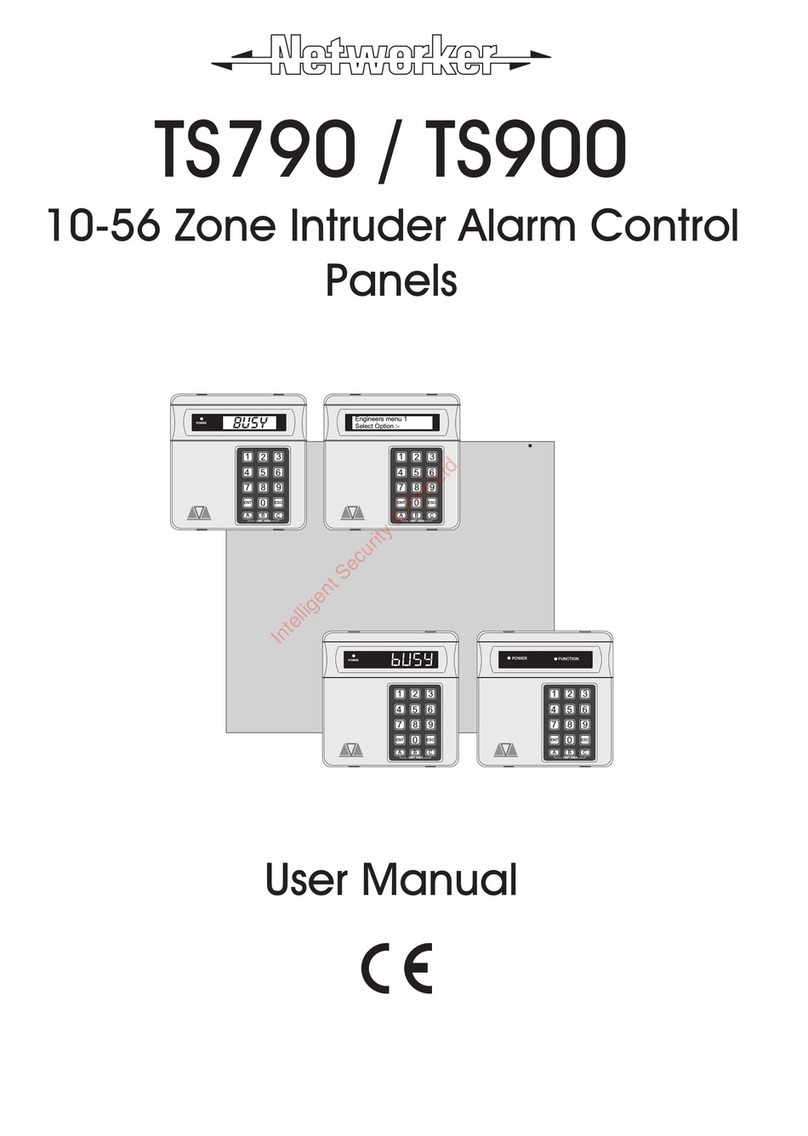
Networker
Networker TS790 User manual
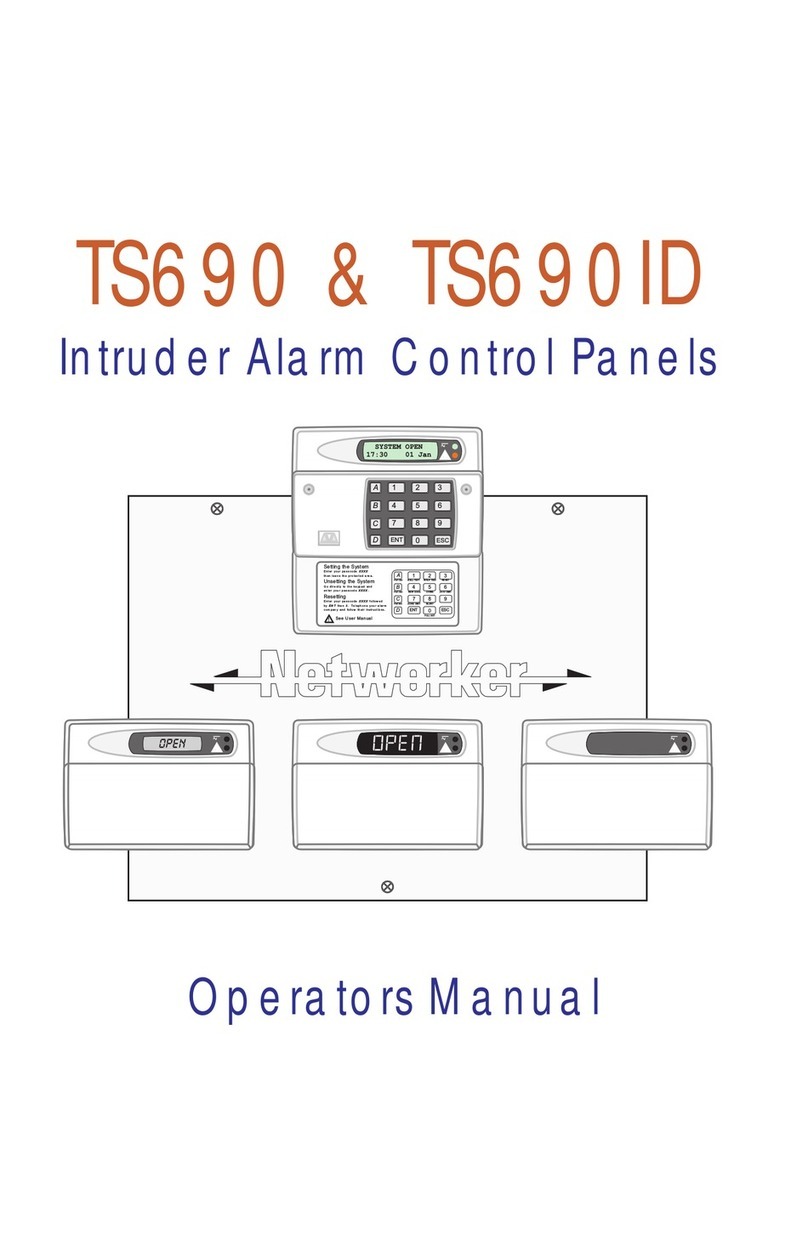
Networker
Networker TS690 User manual
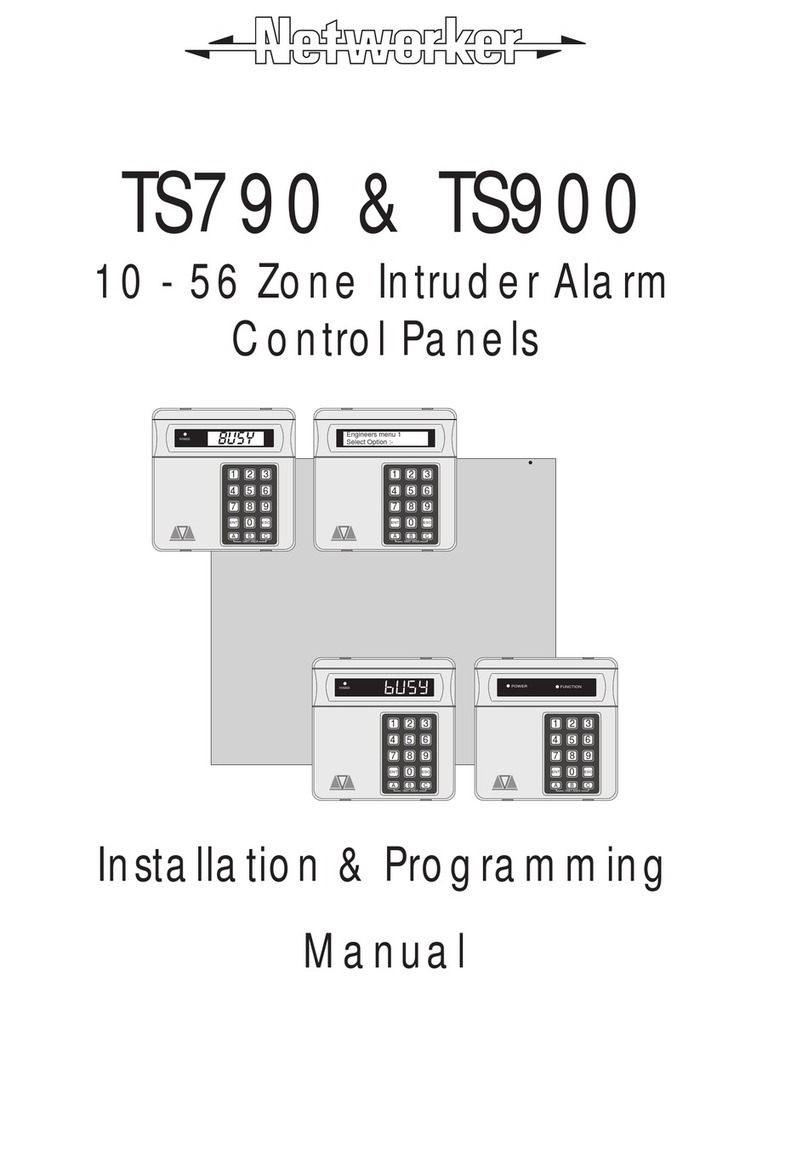
Networker
Networker TS790 Assembly instructions

Networker
Networker TS2500 User manual
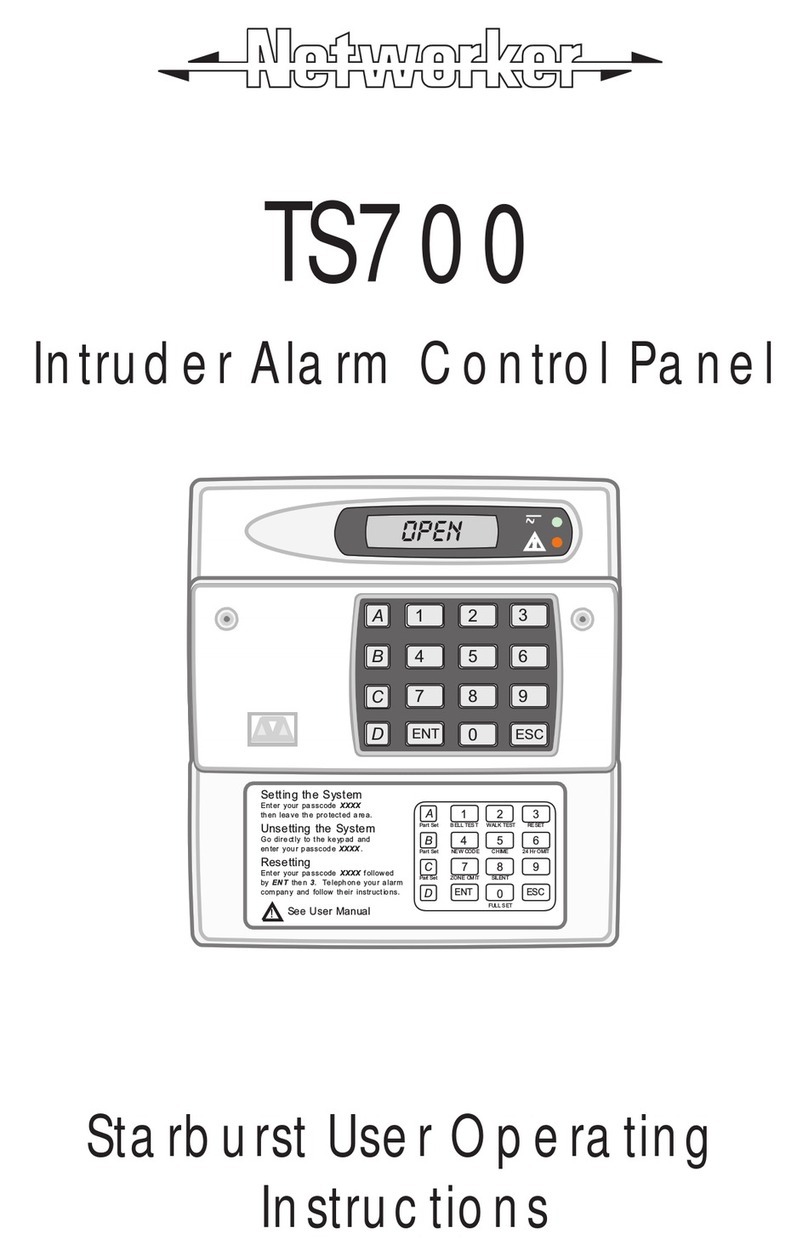
Networker
Networker TS700 Operation instructions

Networker
Networker TS700 Operation instructions
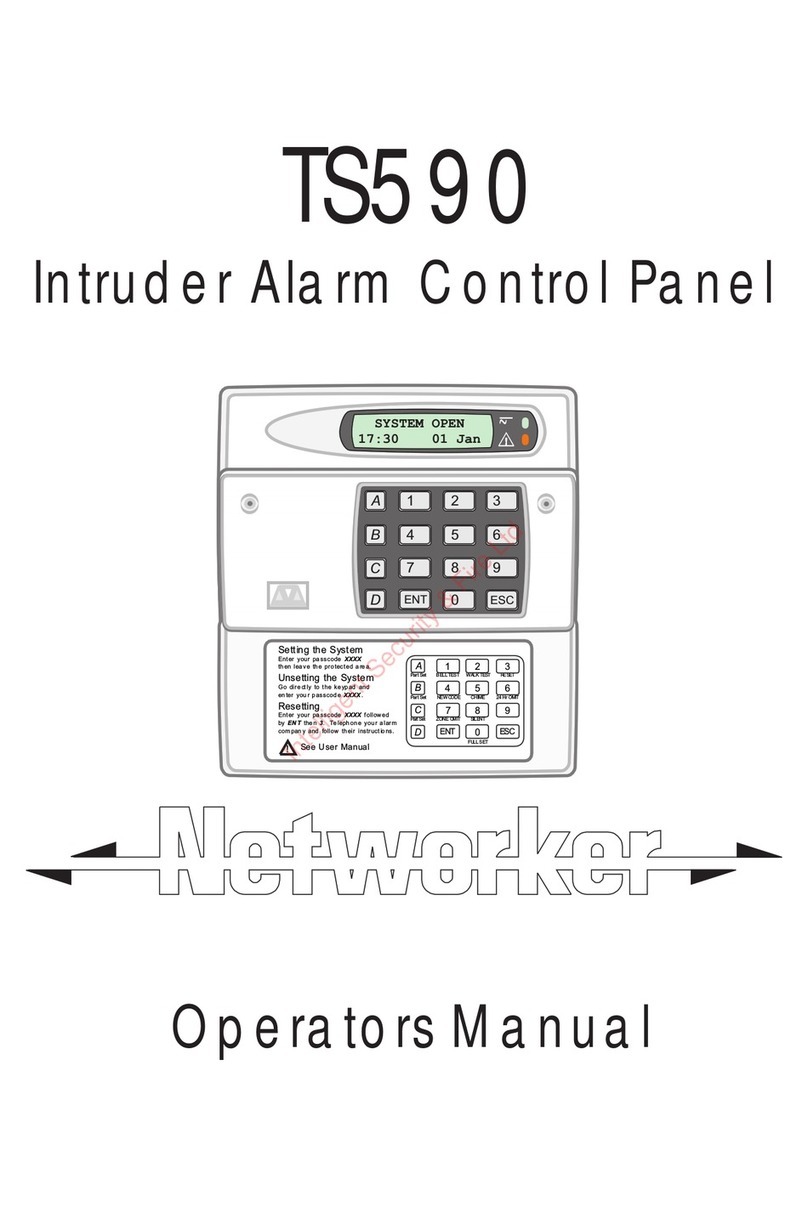
Networker
Networker TS590 User manual
Popular Control Panel manuals by other brands
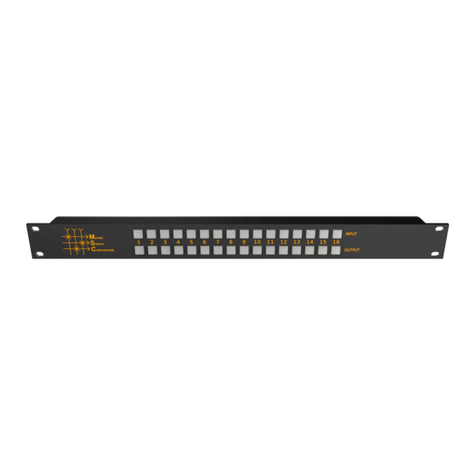
Matrix Switch Corporation
Matrix Switch Corporation MSC-CP16X16E product manual
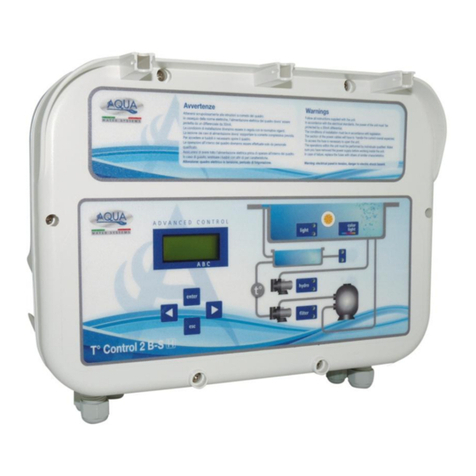
AQUA SPA
AQUA SPA T Control 2 B-S Operation and maintenance manual
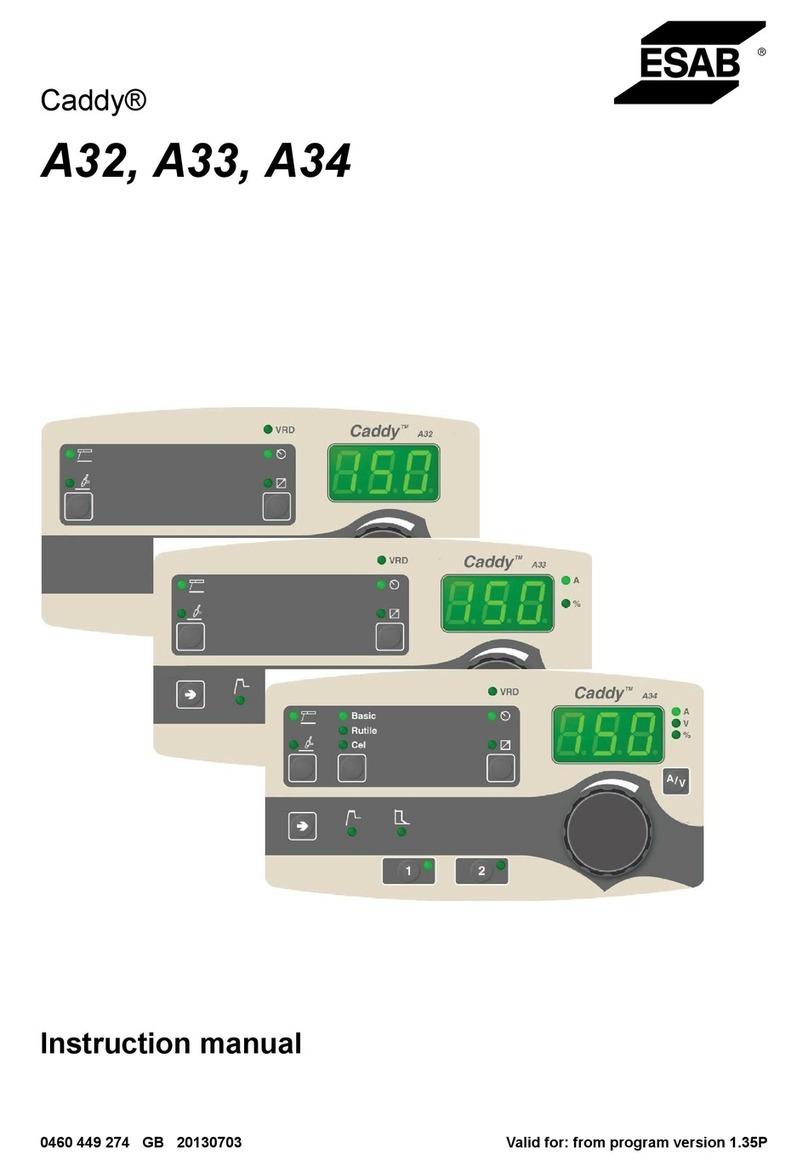
ESAB
ESAB Caddy A32 instruction manual
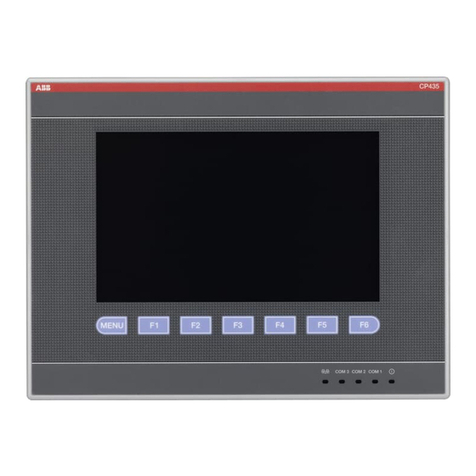
ABB
ABB CP435 Installation and operation manual

Zooper
Zooper Premier EX+ Operation and installation manual
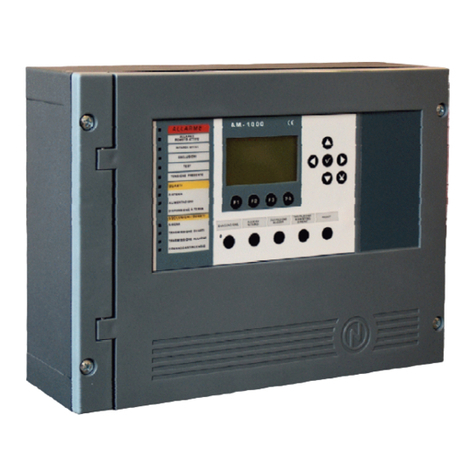
Honeywell
Honeywell NOTIFIER AM1000 Programming manual
